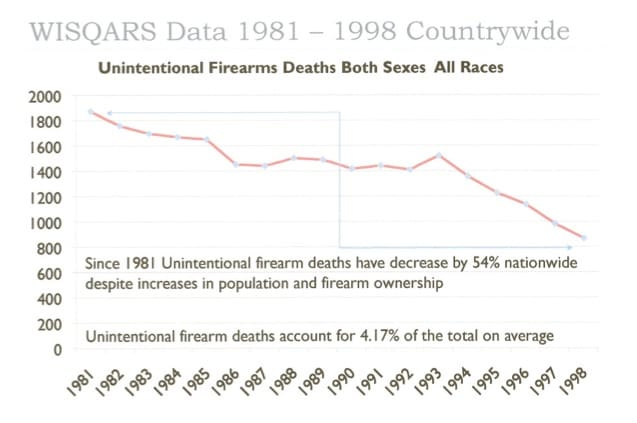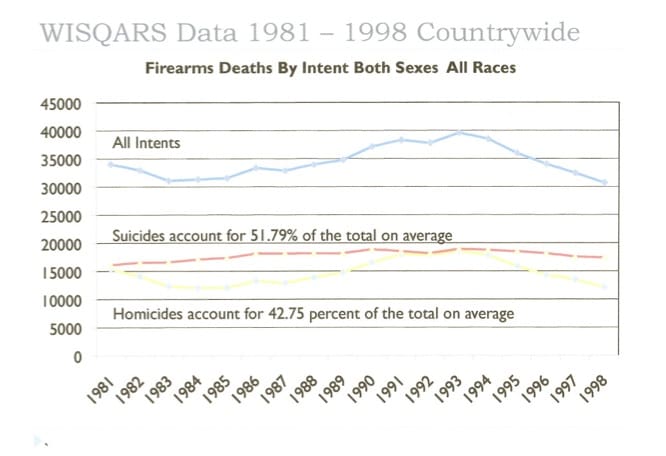 Unintentional firearms deaths have been falling steadily since 1981 and fell off the table in 1993 as the graph plainly shows. The question is why? For the period 1981 to 1998 (the last year data is available) unintentional shooting deaths have dropped by a stunning 54 percent. Contrast this with unintentional poisoning over the same period that increased by 123 percent. Or how about unintentional drowning? Over the same period people drowned accidentally at a rate more than double accidental shooting deaths. What is going on here?
Unintentional firearms deaths have been falling steadily since 1981 and fell off the table in 1993 as the graph plainly shows. The question is why? For the period 1981 to 1998 (the last year data is available) unintentional shooting deaths have dropped by a stunning 54 percent. Contrast this with unintentional poisoning over the same period that increased by 123 percent. Or how about unintentional drowning? Over the same period people drowned accidentally at a rate more than double accidental shooting deaths. What is going on here?
In 1993, according to CDC WISQARS database, there were 1,501 unintentional deaths by gunfire. In 1998 there were 866 a 43 percent decrease in just six years—which is a win in anyone’s playbook. But when is the last time the media reported on any of this? No, they would rather parrot the Brady bunch use of the 30,000 firearms deaths every year without any detail.
Well, let’s talk detail. Shooting deaths peaked in 1993 at 39,595. Yet, 18,940 (48 percent) of these deaths were suicides. Another 18,571 (47 percent) were homicides. For all the ‘rithmatic-challenged out there 95 percent of all firearm deaths were intentional acts of suicide or homicide. After the crack wars ended, firearm deaths fell to 30,708 but again, suicide accounted for 57 percent of the total and homicide 39 percent.
So, take a bow all of you dedicated but unappreciated NRA trainers! Hmmmmm, if only there were 70,000 dedicated poison control instructors out there maybe these deaths would come down too.






I’d love to see that first graph plotted along with the number of guns owned by individuals on the right axis.
The title of the post is misleading. You said “firearms accidents” but the graph and the post are about deaths, which have decreased partly due to improved trauma and emergency treatment.
So trauma and emergency techniques don’t apply to drowning?
Not really. In the majority of drownings, first aid must be applied immediately by untrained personnel (such as parents, siblings, bystanders). In the majority of accidental drownings the victim is alone. There is nothing to draw the attention of people, unlike a gunshot so emergency workers are not dispatched or help called for. Surgery is rarely done in drowning cases. Emergency techniques for drowning are simple and there is little to advance whereas new surgical procedures and technologies are always being discovered for trauma like gun shot wounds.
Military trauma response trickles over to the civilian field as breakthroughs are made.
I recently attended an AF Executive Nursing Symposium where it was shown that a combat casualty currently has a 98% survival rate compared to Vietnam where the rate was about 75%. With new techniques in wound care, bleeding control and fluid replacement your life expectancy has dramatically increased in the last few decades.
You do of course have a reference to a credible study proving your assertion, correct?
Perhaps mandatory firearms training may be useful. If these graphs do indeed reflect that voluntary firearms training has made such a significant reduction in accidental shooting deaths, that is. I am not saying that voluntary safety training isn’t a factor, but this post implies that it is the only factor.
Just as Brad cautioned us yesterday about questioning the data and methodology of the Peace Study he posted, should we not also question the data and methodology of the studies that produced these graphs? Is there any evidence that safety training is the reason for the drop or are there other factors such as safer storage or trigger locks? Can this drop in firearms related deaths be attributed to various state firearms laws enacted since the end of the 1980s?
Why is there no data from the past 12 years? I’d understand if the latest was from 2008 or 2009; it can take a year or two for comprehensive analysis. Did they stop gathering this information and analyzing it? If so, why? Did the trend show no promise in advancing a certain agenda? Ar they burying the data? Do we need an FOI request to get it?
Wasn’t there talk a few years back about the CDC designating firearm-related deaths a “public health crisis”?
According to the CDC, the number of fatal firearms accidents for the period 1999 – 2007 are:
1999 – 824
2000 – 776
2001 – 802
2002 – 762;
2003 – 730;
2004 – 649;
2005 – 630;
2006 – 680;
2007 – 613.
Go to http://webappa.cdc.gov/sasweb/ncipc/mortrate10_sy.html
choose “unintentional” as intent or manner of the injury and “Firearm” as cause or mechanism of the injury. You have to run each year to find the total for that year.
Interesting numbers that bounce around a little but still, they continue to decline.
Thanks 4th.
The data is available through 2007. WISQARS is split 1981-1999, 2000-2007.
Want to see something interesting?
Do the following age range comparisons:
0-12, 13-17,18-24, 25+
You’ll see WHY the Brady’s and anti-gun people use 0-24 in their numbers.
Steady numbers 0-12, Increase 13-17, HUGE increase 18-19, stays high through 24, then decreases by age
That’s not really all that surprising. I am glad to see age distribution breakdown. The 13-24 range is where most accidents (fatal and otherwise) occur through a combination of machismo, hormones and stupidity. You would be hard pressed to find anyone that did something stupid and potentially lethal when they were young who would do that same thing as an experienced adult (although there are those adults who have survived their continued stupidity through luck and good trauma care).
If you look at any other kind of accidental death you will see similar age distributions. If anything these numbers show that children and young adults should either be kept away from firearms or that they should have firearms safety training. I have long advocated that firearms safety should be a part of the primary and secondary school curricula. When I was young, there were hunter training courses at my junior and senior high-schools. If the goal of the gun-control movement is to reduce the number of deaths by firearms, this is an easy way to do it.
Paul, thank you for pointing this out. I didn’t see the data for the years after 1998 and wondered why it was not available.
I was mostly commenting on the faultiness of their statistics by including those 18-24 as “Children”
Fair enough. It is a disingenuous ploy.
However the age group of 0-12 is the most supervised demographic so accidental shootings should be lower than most other demographics anyway. Even if the vast majority of the accidental firearms deaths are older children and young adults, young people are still dying from firearms at a greater rate than any other demographic. That is a problem which should be addressed.
I agree that the young adult (18-24) should be separated out from their categories. Not to do so is alarmist (Think of the children!!1!!1!).
So, does the Homicide stat on the second chart include self-defense shootings?
I’d like to see more people take some sort of firearms training, but no one should be forced to do anything they don’t want to do.
“no one should be forced to do anything they don’t want to do.
Then stay single, my friend.
Staying single won’t do it, lock yourself in a dark room with no telephone, tv or internet.
Joe, at what age do you suggest that start, my son is 30 now but from about 2-25 I can’t even begin to list the things he didn’t want to do.
Seriously, no, safety training alone is/was not the only factor in the reduction. No rational person can believe that any one factor was the only reason. But it has played a part and ignorance can only cause problems whether you are talking about guns, chainsaws, claw hammers or toaster ovens. You can’t keep children safe from drowning by making them wear ankle weights and forbidding their learning to swim. They can’t be kept safe from STD’s by pretending babies are found under cabbages. The gun control groups and politicians like to pretend that there are 250 million guns in the US, they have been spouting that number for 20 years, but the FBI has done over 100 million background checks since the NICS went into operation and says that they are currently doing ~10 million a month. There are more guns than people in the US. Your child IS going to be exposed to a gun at some point in their life, even if it means that you have to “bite the bullet” and learn something uncomfortable yourself, if you don’t teach your child firearms safety you are endangering them and everyone around them when that day comes.
If “gun control” was effective and desirable, Chicago, New York City and the state of New Jersey would be the safest places on earth.
They’re not? Oh dear.
Try looking at the numbers from Wyoming, Vermont or a few other places where guns are common tools and the “laws” are (becoming) more rational. Those “statistics” are truly meaningful, I think.
And yes, training is essential – but must never be “mandatory.” I’ve been a certified firearms and self defense instructor for years and have found that people are generally very eager to learn and prepare to use their tools effectively and safely.
The few people who actually want to harm others don’t mind breaking the laws against murder and assault, or anything else. “Gun control” only disarms the intended victims.
Comments are closed.